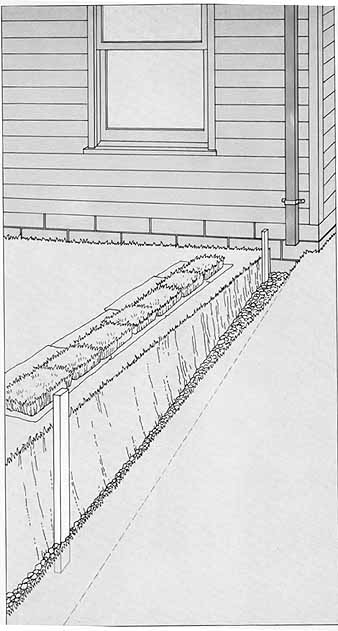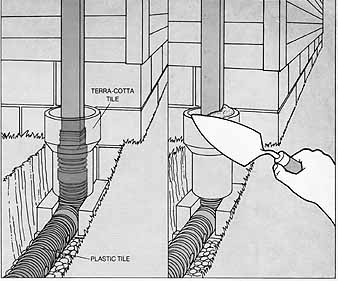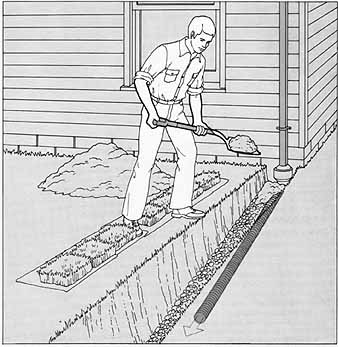Even the most careful gutter maintenance and repair may leave you vulnerable to basement flooding if your down- spouts discharge water directly upon the loose earth near the foundation of a house. Downspouts should drain onto paved areas whenever possible. You can buy ready-made extensions that attach to the end of a downspout and lead to a nearby paved patio or driveway. If no paved area is near the downspout, a splash block made of cement, tile, brick or even plastic and extending 2 or 3 feet from the side of the house will reduce the erosion caused by the water pouring from a downspout. Another alternative is a perforated plastic hose attached to the end of the spout. It unrolls when it's full and squirts water out evenly along its length.
By far the most effective method of conveying gutter water away from the foundation, however, is through buried pipe—generally referred to as tile—3 to 4 inches in diameter, which is attached below ground to an extension of the downspout. Tile traditionally is made of terra cotta, but an improved plastic variety is available for a comparable price. Plastic tile is unbreakable and , because it bends, requires no special pieces for making joints, as does clay pipe.
Tile leading away from the house can extend underground to a storm sewer or culvert if either is nearby, or to a dry well (overleaf). A perforated type of plastic tile (shown on these pages) does not need an outlet; it allows water to seep into the ground along its length in much the same way as the aboveground down spout hose does.

1. Digging the ditch. Measure
a 12-foot stretch from the downspout at a right angle to the side of the
house and mark each end with a stake. Re move foot-wide patches of sod
between the stakes and lay them, grass side down, by the ditch. Using a
pointed shovel, dig a ditch that slopes from 12 inches below the ground
next to the house to a depth of 24 inches at the far end. Line the ditch
with 2 to 4 inches of gravel.

2. Installing the tile. Lay
a 12-foot length of perforated plastic tile 4 inches in diameter along
the ditch. Slip the end of the tile nearest the house into a piece of bell-shaped,
terra-cotta tile slightly larger in diameter than the plastic tile. Slide
the terra-cotta tile into place so it collars the down spout. Prop up the
assembly with bricks. Line the crack between the spout and the bell edges
with cloth or paper; fill the bell with cement.

3. Backfilling the ditch.
Bury the plastic tile under 2 to 4 inches of gravel. Then, starting at
the end nearest the house, backfill the ditch. Lay the sod back in place and gently tamp each piece down with your foot. The slight mound that's created
by the tile will settle in time.